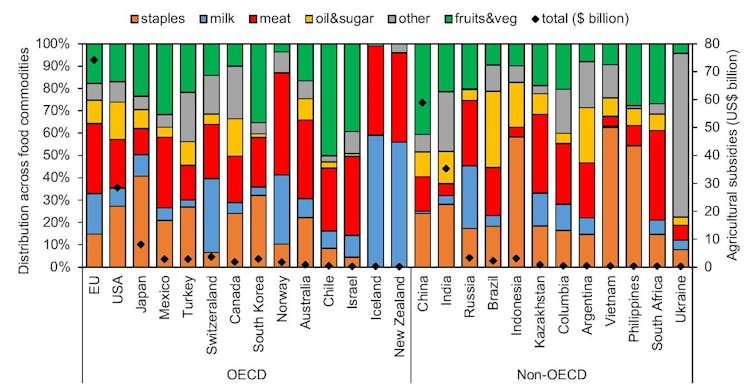How Much Of Our Vegetable Production. Isfor Animal Food?
The global food system is in disarray. Animal agriculture is a major commuter of global heating, and as many every bit 12 million deaths from heart disease, stroke, cancers and diabetes are each year continued to eating the wrong things, like likewise much red and processed meat and too few fruits and vegetables. Unless the world tin can slash the amount of animal products in its food organization and encompass more plant-based diets, there is little chance of avoiding dangerous levels of climatic change and mounting public health issues.
Agronomical subsidies help prop up a food system that is neither salubrious nor sustainable. Worldwide, more than United states of america$200 billion of public money (that is, coin collected through taxes) is given to farmers every year in direct transfers – usually with the intention of supporting national nutrient production and supply.
This might not exist a problem in itself – after all, nosotros all need to eat. But the way governments provide subsidies at the moment exacerbates the wellness and environmental issues of nutrient product. That's one of the findings of a new study published in Nature Communications past my colleague Florian Freund and me.
Agronomical subsidies in action
According to our analysis, about two-thirds of all agricultural transfer payments worldwide come up without any strings attached. Farmers tin use them to grow what they like.
In practice, this means every fifth dollar is used to raise meat, and every tenth dollar to make dairy products – the kinds of foods farmers accept grown used to producing merely which emit disproportionate amounts of greenhouse gas emissions, and which are likewise linked to dietary risks such as center illness and certain cancers.
Farmers use another 3rd of these payments to abound staple crops such as wheat and maize, and crops used for producing sugar and oil. These are foods that are already produced and consumed in big quantities and that, if anything, should be limited in a healthy and sustainable nutrition.

Less than a quarter of transfer payments are used to abound the kinds of foods that are good for man wellness and the environment, and which a good for you and sustainable food system would need much more of: fruits, vegetables, legumes and nuts.
Based on this breakdown, it'south clear there is plenty of room for improving how governments and farmers issue and spend agricultural subsidies. Nosotros decided to expect at alternatives, and compare how they might work in the existent earth.
Where agricultural subsidies go

Reforming subsidies
We combined an economic model which tracked the knock-on furnishings of altering subsidies on food production and the nutrient people eat with an environmental i which compared changes in resources use and greenhouse gas emissions – plus a health model which measured the consequences for nutrition-related illnesses.
In one scenario, we made all subsidy payments to farms conditional on them producing salubrious and sustainable foods. Farmers would however be free to grow other crops and foods, simply non with the support of subsidies. Nosotros found that fruit and vegetable production would go up substantially – by virtually twenty% in developed countries. This would translate into people eating one-half a portion of fruit and veg more than per day. At the same time, meat and dairy production would go downwardly by two% – shaving off 2% from agricultural greenhouse gas emissions.
However, we also constitute that the economy could endure if all subsidies were used in this way, cartoon in workers to farming from more productive parts of the economy.
Fortunately, there are means to avert this. Either make one-half of all subsidies provisional on growing healthy and sustainable foods, or combine these provisional subsidies with a reduction in the overall amount of payments – tying them, for example, to an amount informed by a land's Gross domestic product or population. Each of those options would result in a healthier food supply and less greenhouse gas emissions without reducing economic output.
Baca juga: Why the humble legume could be the answer to Europe's fertiliser addiction
Policymakers in the EU are currently aiming to reduce the environmental impacts of subsidy payments while those in the Uk are because a public money for public appurtenances approach, which pays farmers to provide things similar clean water, wildlife habitat and a nutritious food supply. Sadly, proposals of this kind are often watered down when they're implemented.
Our analysis proposes something which is largely missing from current plans: irresolute the mix of food production. What food farms choose to grow has a greater effect on the environment and health than how it is grown. Redirecting subsidies towards the product of salubrious and sustainable food should be an essential part of reforming agriculture worldwide.

Don't have fourth dimension to read nigh climate change equally much as yous'd like?
Get a weekly roundup in your inbox instead. Every Midweek, The Chat'due south environs editor writes Imagine, a short email that goes a little deeper into only 1 climate issue. Join the 10,000+ readers who've subscribed and so far.
Source: https://theconversation.com/meat-and-dairy-gobble-up-farming-subsidies-worldwide-which-is-bad-for-your-health-and-the-planet-174644
Posted by: lockhartthereenewhe.blogspot.com

0 Response to "How Much Of Our Vegetable Production. Isfor Animal Food?"
Post a Comment